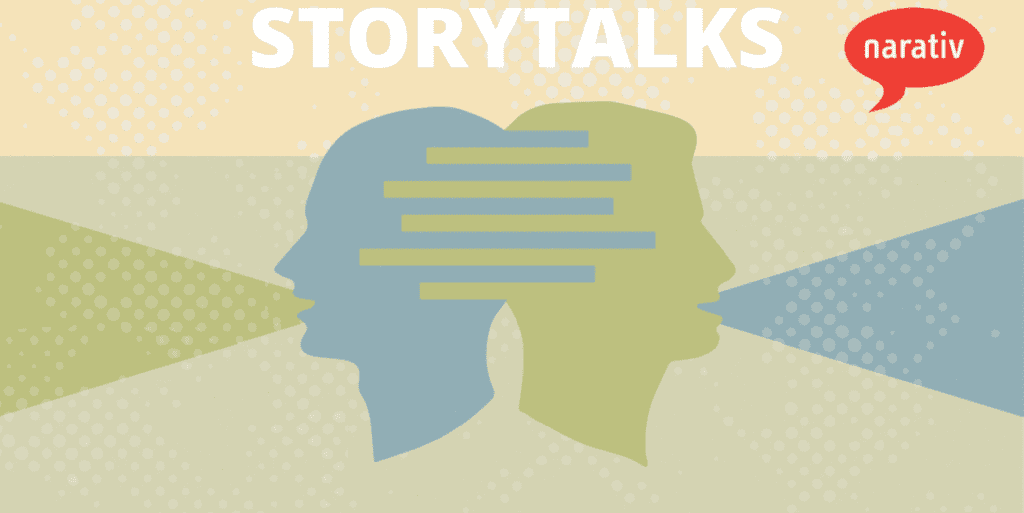Recently on the Narativ podcast StoryTalks, Jerome Deroy and Julienne Ryan met with Matt Bahl of the Financial Health Network. The focus of their conversation was on financial health, which Matt Bahl defined as “when someone’s financial system works together and in concert with individual needs so people can thrive and be resilient.”

To summarize even further: financial health can be viewed as financial resilience—and it goes beyond retirement and insurance benefits. To show the importance of this Matt shared a story about his father. His father never went to college and was a blue-collar type of guy. He had 4 kids while in his twenties as well as a bit of good fortune that allowed him to open a small janitorial business.
Matt’s father never viewed this business as his calling; rather it was a vehicle to provide for his family. Since he owned his business, he didn’t have an exact retirement plan outside of selling the business when he was ready to retire. His priority throughout it all was providing for his children, which the business enabled him to do.

It all seemed to be going well until 2008 happened. Like so many others, Matt’s father lost his business. But that didn’t keep him down. He moved on and found a job at a warehouse and continued to work hard. Then an accident occurred, and he fell from a ladder that put him out of work.
But his story didn’t stop there. Today he’s a security guard at the school his children went to. He has worked for years and years with one priority: his children.
Despite his noble intentions, Matt’s father will likely work into his 70s. He did not squander his chances or lack proper work ethic; he simply suffered from unfortunate circumstances. As Julienne Ryan commented “He did all the right things for all the right reasons,” but life still hit him.
Financial health helps employees overcome these challenges and bounce back from trial after trial. Now you may ask, what does this have to do with my business? A lot.
Building a Healthy Financial Relationship
It may be surprising to hear, but salaries are not what determine financial health. The paycheck, of course, is where it starts, but simply having a paycheck (even a large one) does not guarantee financial health.
There are unexpected costs that come from living life, and your employees’ ability to weather these things is indicative of their financial health. And this resilience goes beyond retirement and insurance.
Matt said, “There is not a proxy statement I’ve seen that does not tout that their workforce is their most important asset, but I think there is a huge lack in action supporting that statement—and I think workers feel that.”
If organizations truly believe their people are their greatest asset, it’s important to make sure there’s not a disconnect between words and actions. This has become such a consistent issue that consumers and workers alike are now consistently asking companies to put their money where their mouth is—and if organizations fail to do so, consumers choose another company that will.
Building these healthy financial relationships becomes more complicated with the trends of Millennials and Gen-Z workforces compared to previous generations. Younger generations are more likely to move from place to place and so pensions and other long-term benefits are less attractive (which has led to most companies not offering them to begin with). And though it may seem like this wouldn’t encourage building up financial health for your employees, it’s actually the exact opposite as Millennials and Gen-Z are more willing to talk with their feet. If you want to keep your workforce, you need to find ways to draw them in and keep them invested.
And these healthy financial relationships go far beyond retirement and insurance benefits; it’s about how your people deal with day-to-day problems like their water heater going out or the fact that so many Americans are just crippled by debt. Employees are asking their employers to step up and help. But how do you do that? Matt, Jerome, and Julienne discussed some simple solutions that make a big difference.
How to Help Your Workers
There are 3 fairly easy steps they talked about in the podcast that can help any business build their employees’ financial health.
1. Provide an emergency fund.
One thing Jerome, Julienne, and Matt brought up was the importance of an emergency fund, and how simple it is for employers to help their employees build one. Even without creating 3 months’ worth of savings, they stressed the idea of simply funding an emergency fund for each employee for $500. This will help with that broken water heater or a car repair they weren’t anticipating.
2. Give employees ownership interest in your company.
The second strategy discussed is to simply give your employees ownership interest in your company. Not only has this been shown to be effective in creating motivation and desirable workplace behaviors, but it also allows your people to succeed as the company does. Ownership interest in the company helps both your company and your employees be more secure.
3. Don’t obsess about the fixtures. Obsess about the plumbing.
Matt said, “There’s an impetus to go add new solutions every time an issue pops up. It’s like an HR version of whack-a-mole… But what about your employee experience? … Just because you build a program doesn’t mean people will come.“
He recommends that, instead, you don’t focus too much on playing that game of whack-a-mole with problems. You want to focus on what the root problems are rather than adding fancy programs that workers may not be attracted to anyways. Focus on the employee experience.
Speaking of which, it can be frustrating to supply programs and benefits to your employees that they don’t take advantage of. One of the best ways to draw in your employees—even into your benefits programs—is through storytelling.
The Value of Storytelling
The most compelling reason to join a benefits program in the workplace doesn’t tend to be the perfectly printed pamphlets. It comes from one coworker speaking to another and discussing how they benefitted from the program—in other words, from the telling of stories.
There is no shortage of data saying why all of this matters, but it’s not enough to move hearts and minds. You need the stories.
Matt Bahl said, “Data without storytelling is as useless as storytelling without data.”
Storytelling humanizes the issues. It enables you to see yourself in the shoes of the people who are having a rough time. You need the data to know the numbers and be informed, but you also need the story to make it compelling—to give it a soul. That is what will draw people in and engage them. Then your programs can do the rest of the work.
Building a Future for Your Employees
There’s a lot to cover in the ever-changing sea of financial health. It can be hard to take it all in. This is why there are resources to help. What is most important is adapting to help your employees achieve the financial health they deserve while building a system that benefits you and them. Be sure to catch the full episode of the StoryTalks podcast for yourself here.
If you are interested in learning more, Jerome is always happy to discuss how storytelling can help your company reach new heights.





